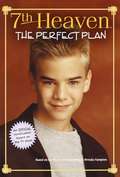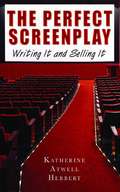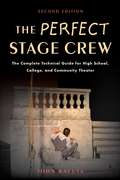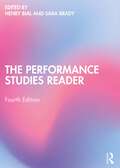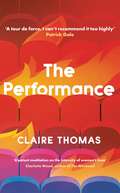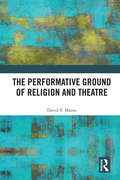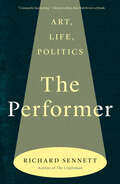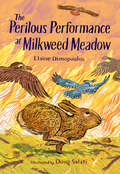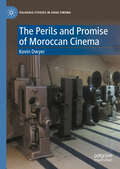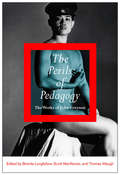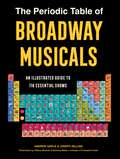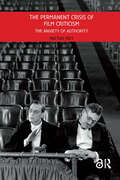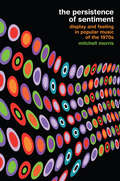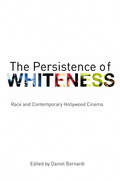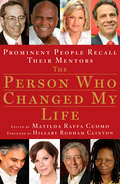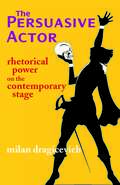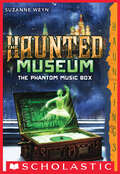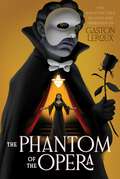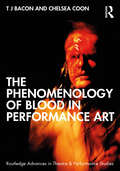- Table View
- List View
The Perfect Plan (7th Heaven)
by Amanda ChristieLucy and Mary are definitely up to something, but the rest of the family is so busy they don't seem to notice--except for sharp-eyed Simon, who's got a big surprise in store for his older sisters!
The Perfect Screenplay: Writing It and Selling It
by Katherine HerbertThey say in L.A. everybody is writing a screenplay. With The Perfect Screenplay, everybody everywhere will be writing well-presented, saleable screenplays. Packed with tips from an insider on how Hollywood operates, testing script ideas, building structure, and marketing the final screenplay, this book is the key to getting work read and sold. A resource list gives Web sites, agents, and more. Writers will be thanking the little people-and The Perfect Screenplay. Written by a top Hollywood script analyst From computer screen to silver screen in clear, easy-to-follow steps
The Perfect Stage Crew: The Complete Technical Guide for High School, College, and Community Theater
by John KalutaHere is a must-have book for anyone producing a stage show without a Broadway-sized budget. Written by a technical theater veteran, The Perfect Stage Crew explains the pitfalls to avoid and provides solutions to the most common-and the most complex-stage performance problems, even for theaters with a lack of resources. An invaluable guide for middle and high school theaters, college theaters, and community theaters, The Perfect Stage Crew teaches readers how to:Stock, organize, and store the essential backstage suppliesConceptualize, design, and build setsManage a stage crew effectivelyPaint scenery and backdropsTest, design, and hang lightingOperate and repair sound equipmentSet cuesPromote your showThis expanded second edition covers up-to-date technology, including for use with recording, sound, and lighting. Chapters also cover such crucial topics as running technical rehearsals, gathering props, and creating and selling tickets. Theater groups that need to learn the nuts and bolts of putting a show together will discover how to turn backstage workers into The Perfect Stage Crew.Allworth Press, an imprint of Skyhorse Publishing, publishes a broad range of books on the visual and performing arts, with emphasis on the business of art. Our titles cover subjects such as graphic design, theater, branding, fine art, photography, interior design, writing, acting, film, how to start careers, business and legal forms, business practices, and more. While we don't aspire to publish a New York Times bestseller or a national bestseller, we are deeply committed to quality books that help creative professionals succeed and thrive. We often publish in areas overlooked by other publishers and welcome the author whose expertise can help our audience of readers.
The Perfect Story: How to Tell Stories that Inform, Influence, and Inspire
by Karen Eber"Come for the engrossing content, and stay for the lessons that might just change how you talk, write, and lead.&” —Adam GrantLearn how to take any story and make it perfect—from storytelling expert Karen Eber, whose popular TED Talk on the subject continues to be a source of inspiration for millions.What makes a story perfect? How do you tell the perfect story for any occasion?We live in a story world. Stories are a memorable and engaging way to differentiate yourself, build connection and trust, create new thinking, bring meaning to data, and even influence decision-making. But how do you turn a good story into a great story that informs, influences, and inspires?In The Perfect Story, Karen Eber—leadership consultant, professional keynote storyteller, and TED speaker—shares the science of storytelling to teach you to:Leverage the Five Factory Settings of the Brain to hack the art of storytellingBuild a toolkit of endless story ideasDefine the audience for your storyApply a memorable story structureEngage senses and emotionsTell stories with dataAvoid common storytelling mistakesUse your body to tell dynamic storiesEnsure your story doesn't manipulateNavigate and embrace the vulnerability of storytellingWithout relying on complicated models or one-size-fits-all prescriptions, this book makes storytelling accessible with practical and impactful steps for anyone to tell the perfect story for any occasion.Through interview vignettes, The Perfect Story also shares approaches from different storytellers, including the Sundance Institute cofounder, an executive producer of The Moth, the former creative director at Pixar, the TED Radio Hour podcast host, and many more.Whether you are leading a team, giving a presentation, hosting a podcast, selling a product or service, interviewing for a job, or giving a toast at a wedding, The Perfect Story will help you take your stories and make them perfect.
The Performance Studies Reader
by Sara Brady Henry BialSince its first publication in 2004, The Performance Studies Reader has become the leading anthology of key writings on performance studies. Now in its fourth edition, it continues to offer an unparalleled selection of work by the foremost scholars in this continually evolving field, offering a stimulating introduction to the crucial debates of Performance Studies. These critical and theoretical contributions are joined in this edition by 26 new chapters, bringing the collection up to date with current discourse and ideas, and significantly expanding the range of subjects and authors represented. Each essay includes contextual headnotes from the editors, to introduce students to the writer and their impact on the field. Newly added to this edition are contributions from Swati Arora; Sara Ahmed; Sarah Bay-Cheng; Claire Bishop; Felipe Cervera, Theron Schmidt, and Hannah Schwadron; Anita E. Cherian and Gargi Bharadwaj; Thomas F. DeFrantz/SLIPPAGE; Soyica Diggs Colbert; Tracy C. Davis; Saidiya V. Hartman; Travis Jackson; Branislav Jakovljević; Ailton Krenak; André Lepecki; Fred Moten; José Esteban Muñoz; Tavia Nyong'o; Tamara Searle; Stephanie Nohelani Teves; and McKenzie Wark.This new edition of The Performance Studies Reader provides an overview of the full range of performance theory for undergraduates at all levels, and beginning graduate students in Performance Studies, theatre, performing arts, and cultural studies.
The Performance of Nationalism
by Jisha MenonImagine the patriotic camaraderie of national day parades. How crucial is performance for the sustenance of the nation? The Performance of Nationalism considers the formation of the Indian and Pakistani nation, in the wake of the most violent chapter of its history: the partition of the subcontinent. In the process, Jisha Menon offers a fresh analysis of nationalism from the perspective of performance. Menon recuperates the manifold valences of "mimesis" as aesthetic representation, as the constitution of a community of witnesses, and as the mimetic relationality that underlies the encounter between India and Pakistan. The particular performances considered here range from Wagah border ceremonies, to the partition theatre of Asghar Wajahat, Kirti Jain, M. K. Raina, and the cinema of Ritwik Ghatak and M. S. Sathyu. By pointing to the tropes of twins, doubles, and doppelgangers that suffuse these performances, this study troubles the idea of two insular, autonomous nation-states of India and Pakistan. In the process, Menon recovers mimetic modes of thinking that unsettle the reified categories of identity politics.
The Performance: A Novel
by Claire Thomas'Quietly transformational'The Times 'A tour de force... I can't recommend this too highly'Patrick Gale'Innovative... an original, at-a-sitting read'Daily Mail'A potent meditation on the intensity of women's lives'Charlotte Wood, author of The Weekend'A miracle... Engaging and evocative'Washington Post'I loved and admired The Performance... Unmissable'Emma Stonex, author of The Lamplighters'Lively and intimate... The way Thomas plays with the reader is a sort of genius'Guardian'Thomas writes these women with such wisdom and compassion, that by the end we are all transformed'Claire Fuller, author of Unsettled Ground The false cold of the theatre makes it hard to imagine the heavy wind outside in the real world, the ash air pressing onto the city from the nearby hills where bushfires are taking hold.The house lights lower.The auditorium feels hopeful in the darkness.As bushfires rage outside the city, three women watch a performance of a Beckett play.Margot is a successful professor, preoccupied by her fraught relationship with her ailing husband. Ivy is a philanthropist with a troubled past, distracted by the snoring man beside her. Summer is a young theatre usher, anxious about the safety of her girlfriend in the fire zone.As the performance unfolds, so does each woman's story. By the time the curtain falls, they will all have a new understanding of the world beyond the stage.
The Performative Ground of Religion and Theatre
by David V. MasonReligious practitioners and theatregoers have much in common. So much, in fact, that we can say that religion is often a theatrical phenomenon, and that theatre can be a religious experience. By examining the phenomenology of religion, we can in turn develop a better understanding of the phenomenology of theatre. That is to say, religion can show us the ways in which theatre is not fake. This study explores the overlap of religion and theatre, especially in the crucial area of experience and personal identity. Reconsidering ideas from ancient Greece, premodern India, modern Europe, and the recent century, it argues that religious adherents and theatre audiences are largely, themselves, the mechanisms of their experiences. By examining the development of the philosophy of theatre alongside theories of religious action, this book shows how we need to adjust our views of both. Featuring attention to influential notions from Plato and Aristotle, from the Natyashastra, from Schleiermacher to Sartre, Bourdieu, and Butler, and considering contemporary theories of performance and ritual, this is vital reading for any scholar in religious studies, theatre and performance studies, theology, or philosophy.
The Performer: Art, Life, Politics
by Richard SennettAn acclaimed sociologist’s exploration of the connections among performances in life, art, and politics “A thought-provoking, essayistic and touchingly personal exploration of the ethics and aesthetics of performance from one of the leading intellectuals of our time.”—Lucasta Miller, The Spectator, “Best Books of 2024” “Constantly fascinating and often illuminating.”—Simon Callow, New York Review of Books In The Performer, Richard Sennett explores the relations between performing in art (particularly music), politics, and everyday experience. It focuses on the bodily and physical dimensions of performing, rather than on words. Sennett is particularly attuned to the ways in which the rituals of ordinary life are performances. The book draws on history and sociology, and more personally on the author’s early career as a professional cellist, as well as on his later work as a city planner and social thinker. It traces the evolution of performing spaces in the city; the emergence of actors, musicians, and dancers as independent artists; the inequality between performer and spectator; the uneasy relations between artistic creation and social and religious ritual; the uses and abuses of acting by politicians. The Janus-faced art of performing is both destructive and civilizing.
The Performing Artist's Handbook
by Janice PapolosThe right ways to handle all of the nonmusical essentials of your career, the practical know-how you need to progress in your professional music career.
The Performing Subject in the Space of Technology
by Matthew CauseyNow that the shock of the virtual has subsided toward a 'new-normal' of computational interference in all areas of life, it is an advantageous moment to reflect on the passage through the virtual and back to the real. Digital culture has developed into a bio-virtual environment in which the categories of the biological and the virtual no longer stand as separate. The contributors to this volume respond to the questions raised by the 'after-event' of the digital through practice-led researchanalyses of performance processes, philosophical readings of the work of art and technology, and performance studies investigations of the subject in the spaces of technology. The volume examines a wide range of activities, from bio-art to internet child pornography, gaming and social networking technologies to the use of motion-tracking in developing choreography and documentation. The authors draw from diverse perspectives in dance, theatre, performance, film and music studies, digital arts and culture.
The Perilous Performance at Milkweed Meadow
by Elaine DimopoulosButternut and the meadow creatures return in this middle-grade adventure sequel that will charm animal-loving fans of The Tale of Despereaux and Clarice the Brave. Illustrated by Caldecott winner Doug Salati.After their remarkable rescue, the meadow creatures are back—now closer than ever and with beloved rabbit Butternut still captivating them all with her storytelling. But when a dazzling group of traveling turkeys shows up and persuades the meadow creatures to join them in putting on performance, Butternut is not sure she can find her place in all the excitement. She questions her storytelling abilities compared to this new crew.When it turns out the turkeys—and the grand show—are not what they seem, Butternut's family and friends are suddenly in imminent danger. Butternut must figure out how to trust herself and find help. In the end, the hope is that friendship will win once more.Beautiful and arresting black-and-white illustrations bring the animals to life in this nail-biting and heartwarming story about trust: trusting our instincts, trusting our creative talents, and trusting those who know and love us, even when it&’s hard.&“Treasured classics designed to be read aloud and shared.&”—Caroline Carlson, author of Wicked Marigold
The Perils and Promise of Moroccan Cinema (Palgrave Studies in Arab Cinema)
by Kevin DwyerBased on extended field research and meetings with members of Morocco’s film world, this book traces the development of Moroccan cinema over the past three decades. Drawing from his extensive work on Moroccan cinema, Kevin Dwyer discusses important aspects of Moroccan film culture such as freedom of expression, the role of women, cultural diversity, the promotion of culture, the role of humor, the shifting emphasis on the urban, autobiographical aspects of films, and the development of documentary films. Dwyer closely analyzes a significant number of Moroccan films, providing crucial details about filmmakers; historical context; and comparisons with the cinemas of Tunisia, Algeria, and Egypt.
The Perils of Pedagogy
by Scott Mackenzie Thomas Waugh Brenda LongfellowWhether addressing HIV/AIDS, the policing of bathroom sex, censorship, or anti-globalization movements, John Greyson has imbued his work with cutting humour, eroticism, and postmodern aesthetics. Mashing up high art, opera, community activism, and pop culture, Greyson challenges his audience to consider new ways that images can intervene in both political and public spheres. Emerging on the Toronto scene in the late 1970s, Greyson has produced an eclectic, provocative, and award-winning body of work in film and video. The essays in The Perils of Pedagogy range from personal meditations to provocative textual readings to studies of the historical contexts in which the artist's works intervened politically as well as artistically. Notable writers from a range of disciplines as well as prominent experimental and activist filmmakers tackle questions of documentary ethics, moving image activism, and queer coalitional politics raised by Greyson's work. Close to one hundred frame captures and stills from almost sixty works, along with articles, speeches, and short scripts by Greyson - several never before published - supplement the collection. Celebrating thirty years of passionate, brilliant, and affecting moviemaking, The Perils of Pedagogy will fascinate both specialists and general readers interested in media activism and advocacy, censorship, and freedom of expression.
The Perils of Pedagogy: The Works of John Greyson
by Thomas Waugh Brenda Longfellow Scott MacKenzieWhether addressing HIV/AIDS, the policing of bathroom sex, censorship, or anti-globalization movements, John Greyson has imbued his work with cutting humour, eroticism, and postmodern aesthetics. Mashing up high art, opera, community activism, and pop culture, Greyson challenges his audience to consider new ways that images can intervene in both political and public spheres. Emerging on the Toronto scene in the late 1970s, Greyson has produced an eclectic, provocative, and award-winning body of work in film and video. The essays in The Perils of Pedagogy range from personal meditations to provocative textual readings to studies of the historical contexts in which the artist's works intervened politically as well as artistically. Notable writers from a range of disciplines as well as prominent experimental and activist filmmakers tackle questions of documentary ethics, moving image activism, and queer coalitional politics raised by Greyson's work. Close to one hundred frame captures and stills from almost sixty works, along with articles, speeches, and short scripts by Greyson - several never before published - supplement the collection. Celebrating thirty years of passionate, brilliant, and affecting moviemaking, The Perils of Pedagogy will fascinate both specialists and general readers interested in media activism and advocacy, censorship, and freedom of expression.
The Periodic Table of Broadway Musicals: An Illustrated Guide to 118 Essential Shows
by Andrew Gerle Joseph ZellnikTheater lovers will adore this unique guidebook that boasts a wealth of Broadway knowledge, including adorable icons that represent each musical. Imagine the classic periodic table of elements—but instead of Chromium and Rhodium, it's A Chorus Line and RENT! This delightful and informative gift book, based on the bestselling viral poster series is a stunning showcase of art and content sure to thrill lovers of showtunes and everything Broadway and beyond. Includes a full-size pull-out poster.
The Permanent Crisis of Film Criticism: The Anxiety of Authority (Film Theory in Media History)
by Mattias FreyFilm criticism is in crisis. Dwelling on the many film journalists made redundant at newspapers, magazines, and other 'old media' in past years, commentators have voiced existential questions about the purpose and worth of the profession in the age of WordPress blogospheres and proclaimed the 'death of the critic'. Bemoaning the current anarchy of internet amateurs and the lack of authoritative critics, many journalists and academics claim that in the digital age, cultural commentary has become dumbed down and fragmented into niche markets. Mattias Freu, arguing against these claims, examines the history of film critical discourse in France, Germany, the United Kingdom, and the United States. He demonstrates that since its origins, film criticism has always found itself in crisis: the need to show critical authority and the anxieties over challenges to that authority have been longstanding concerns.
The Persistence of Hollywood
by Thomas ElsaesserWhile Hollywood’s success – its persistence – has remained constant for almost one hundred years, the study of its success has undergone significant expansion and transformation. Since the 1960s, Thomas Elsaesser’s research has spearheaded the study of Hollywood, beginning with his classic essays on auteurism and cinephilia, focused around a director’s themes and style, up to his analysis of the "corporate authorship" of contemporary director James Cameron. In between, he has helped to transform film studies by incorporating questions of narrative, genre, desire, ideology and, more recently, Hollywood’s economic-technological infrastructure and its place within global capitalism. The Persistence of Hollywood brings together Elsaesser’s key writings about Hollywood filmmaking. It includes his detailed studies of individual directors (including Minnelli, Fuller, Ray, Hitchcock, Lang, Altman, Kubrick, Coppola, and Cameron), as well as essays charting the shifts from classic to corporate Hollywood by way of the New Hollywood and the resurgence of the blockbuster. The book also presents a history of the different critical-theoretical paradigms central to film studies in its analysis of Hollywood, from auteurism and cinephilia to textual analysis, Marxism, psychoanalysis, and post-industrial analysis.
The Persistence of Sentiment: Display and Feeling in Popular Music of the 1970s
by Mitchell MorrisHow can we account for the persistent appeal of glossy commercial pop music? Why do certain performers have such emotional power, even though their music is considered vulgar or second rate? In The Persistence of Sentiment, Mitchell Morris gives a critical account of a group of American popular music performers who have dedicated fan bases and considerable commercial success despite the critical disdain they have endured. Morris examines the specific musical features of some exemplary pop songs and draws attention to the social contexts that contributed to their popularity as well as their dismissal. These artists were all members of more or less disadvantaged social categories: members of racial or sexual minorities, victims of class and gender prejudices, advocates of populations excluded from the mainstream. The complicated commercial world of pop music in the 1970s allowed the greater promulgation of musical styles and idioms that spoke to and for exactly those stigmatized audiences. In more recent years, beginning with the "Seventies Revival" of the early 1990s, additional perspectives and layers of interpretation have allowed not only a deeper understanding of these songs' function than when they were first popular, but also an appreciation of how their significance has shifted for American listeners in the succeeding three decades.
The Persistence of Whiteness: Race and Contemporary Hollywood Cinema
by Daniel BernardiThe Persistence of Whiteness investigates the representation and narration of race in contemporary Hollywood cinema. Ideologies of class, ethnicity, gender, nation and sexuality are central concerns as are the growth of the business of filmmaking. Focusing on representations of Black, Asian, Jewish, Latina/o and Native Americans identities, this collection also shows how whiteness is a fact everywhere in contemporary Hollywood cinema, crossing audiences, authors, genres, studios and styles. Bringing together essays from respected film scholars, the collection covers a wide range of important films, including Guess Who’s Coming to Dinner, The Color Purple, Star Wars and The Lord of the Rings. Essays also consider genres from the western to blaxploitation and new black cinema; provocative filmmakers such as Melvin Van Peebles and Steven Spielberg and stars including Whoopi Goldberg and Jennifer Lopez. Daniel Bernardi provides an in-depth introduction, comprehensive bibliography and a helpful glossary of terms, thus providing students with an accessible and topical collection on race and ethnicity in contemporary cinema.
The Person Who Changed My Life: Prominent People Recall Their Mentors
by Matilda CuomoAt some point in our lives, most of us have been affected by caring adults whose advice, guidance, and example made a difference. In The Person Who Changed My Life, individuals who have distinguished themselves in their fields write about the men and women who served as their mentors. Among the contributors in this updated and expanded edition of Matilda Raffa Cuomo's first book are Hillary Rodham Clinton, Joe Torre, Rosie O'Donnell, Dr. Mehmet Oz, Nora Ephron, General Colin Powell, and many others. The contributors evoke the people who had a lasting influence on their personal and professional lives and, in the process, show how profoundly a mentor can impact the life of a young, or not so young, person.The book includes a resource section for readers who are inspired to get involved and become mentors or help start mentoring organizations in their own communities. These moving stories by people who have excelled in their professions through hard work, perseverance, and, most important, the helpful assistance of others, demonstrate the long-lasting impact a mentor can have--and emphasize the importance of passing on the gifts our mentors give us.
The Persuasive Actor: Rhetorical Power on the Contemporary Stage
by Milan Dragicevich"A must-have for all actors who encounter speeches that are longer than three sentences. On the surface, that would be classic works from Sophocles through Shakespeare—with the 17th and 18th centuries thrown in. Dig deeper and the book’s value to actors of modern and contemporary drama is inescapable. Ibsen, Shaw, Williams, Miller, Shepard, Wilson, Kushner, and Suzan-Lori Parks all wrote plays that are filled with powerful rhetorical devices that demand lively, thorough, and specific consideration. This book is a guide that unfolds the mysteries of classical rhetoric in a clear, concise, and effective manner, a book for speakers who want to move their audiences. It is aimed at actors, but also belongs on the shelf of lawyers, advertising copywriters, and, of course, public officials. I will use it in my classes and workshops and enthusiastically recommended it to all actors and actor trainers." —Leslie Reidel, Department of Theatre, University of Delaware
The Phantom Music Box: The Phantom Music Box (The Haunted Museum #2)
by Suzanne WeynA mysterious music box from the Haunted Museum follows a young girl home in this spooky read by the author of The Titanic Locket.Don’t touch anything in the Haunted Museum!Emma would rather be at her ballet class than at the Haunted Museum, but she can’t miss her best friend’s birthday party. In a spooky exhibit of music boxes, she’s drawn to a particular one, in which a pair of dancers spin slowly to a haunting melody.But that very night, the music box shows up at her door—like it’s following her. Emma dances better than she ever imagined when the music box is playing. But that’s not all. Sometimes the music speeds up, and the dancers seem to move on their own. Emma finds the lid open, music playing, even when she knows she’d shut it before. And then an eye appears in the mirror inside the lid—someone is watching Emma!The more Emma learns about the history of the music box, the more she realizes she needs to break the hold it has over her before it’s too late. But the better she dances when the music plays, the less she wants to!Praise for The Titanic Locket“Hair-raising. . . . Weyn keeps unexpected chills coming. . . . A quick, jittery read.” —Publishers Weekly“Weyn ratchets up the eeriness . . . and quickly builds to a stormy climax.” —Kirkus Reviews
The Phantom of the Opera (Monstrous Classics Collection)
by Gaston LerouxA new generation of young readers is sure to delight in this enduring tale of love and torment by Gaston Leroux originally published in 1909—featuring a freshly reimagined cover!Filled with the spectacle of the Paris Opera House in the 19th century, this classic work of suspense remains a riveting journey into the dark regions of the human heart. The tale begins as an investigation into the strange stories of an &“Opera ghost,&” said to scare performers as they sit alone in their dressing rooms or walk along the building&’s labyrinthine corridors. But it isn&’t until the triumphant performance of beautiful soprano Christine Daaé that the Phantom begins his attacks—striking terror in the hearts of everyone in the theater.
The Phenomenology of Blood in Performance Art (Routledge Advances in Theatre & Performance Studies)
by T. J. Bacon Chelsea CoonThe Phenomenology of Blood in Performance Art is a major new publication that expands the philosophical contextualisation of blood, its presence and absence, across the practice of performance art from a phenomenological perspective.Edited by T. J. Bacon (she/they) and Chelsea Coon (she/her), this book moves through an established cannon of artists and beyond to ensure an inclusive representation of practices from a wider range of practitioners. First-hand interviews and conversations have been gathered from both canonical names as well as individuals who are prevalent in their communities and/or respective subcultures, but less represented within the frameworks of scholarly discourse. Each offers the opportunity to examine their experiences creating artworks and in turn contributes to the context of phenomenological examination within this publication through complementary scholarly texts from leading thinkers who frame phenomenological application to both visual art and transdisciplinary context. Featuring artists through new exclusive interviews and contributions including Marina Abramović, Jelili Atiku, Ron Athey, Franko B, Niya B, Marisa Carnesky, Chelsea Coon, Victor Martinez Diaz, Rufus Elliot, Ernst Fischer, Louis Fleischauer, Poppy Jackson, Mirabelle Jones, Andrei Molodkin, Hermann Nitsch, ORLAN, Mike Parr, Greta Sharp, tjb and Paola Paz Yee, and reference to many more. Alongside new scholarly insight by leading phenomenological and interdisciplinary art scholars and philosophers including T. J. Bacon, Chelsea Coon, Stuart Grant, Kelly Jordan, Lynn Lu, Roberta Mock, Amber Musser and Raegan Truax. Together they represent a significant exploration of intricate and dynamic responses to the cultural fabric of contemporary lived experiences across space and time through the medium of blood in performance art.This incredible analysis of this performance art will be of huge interest to students and practitioners of live art, performance art, phenomenology, and performance philosophy.
